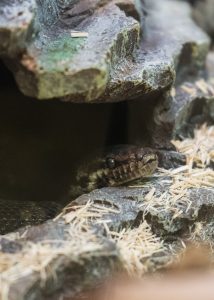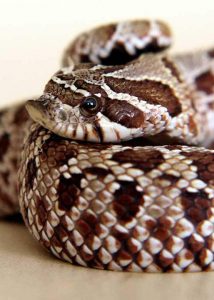Reptiles
Children’s Python
 COMMON NAME: Children’s Python
COMMON NAME: Children’s Python
SCIENTIFIC NAME: Antaresia childreni
Found in Australia and neighboring islands, the Children’s Python is named for John George Children, a zoological curator at the British Museum and mentor of John Edward Grey, who published the original description of the species in 1842.
Like other pythons, the Children’s is a non-venomous constrictor, with a diet consisting mostly of smaller reptiles, birds, and mammals.
Fun facts: This specimen is known to inhabit cave systems, hanging from stalactites, and feeding upon microbats.
Cuvier’s Dwarf Caiman
 COMMON NAME: Cuvier’s Dwarf Caiman
COMMON NAME: Cuvier’s Dwarf Caiman
SCIENTIFIC NAME: Paleosuchus palpebrosus
This Amazonian reptile is the smallest member of the crocodilian family, growing to an average of four to five feet in length. It is a freshwater species, making its home in fast moving rivers, as well as flooded forest land. Its diet consists of fish, amphibians, small mammals, and invertebrates.
Fun facts: These small crocodilians are capable of swimming up to thirty miles per hour.
Leopard Tortoise
 COMMON NAME: Leopard Tortoise
COMMON NAME: Leopard Tortoise
SCIENTIFIC NAME: Stigmochelys pardalis
This Tortoise is named for their yellow and black, cylindrically patterned shell, which resembles the pattern of Leopard spots. Found amongst the savannah grassland of Sub-Saharan Africa, the Leopard Tortoise is considered the fourth largest Tortoise in the world behind the Galapagos, Aldabra Giant, and African Spurred Tortoises.
They feed on a range of vegetation, including grasses, succulents, prickly pear, thistle, and watermelon.
Female Leopard Tortoises may lay up to thirty eggs in a single nest, and their eggs may incubate from five months, to over a year before hatching, depending on seasonal conditions.
Fun Fact: Leopard Tortoises are capable of living for over 100 years.
Red-footed Tortoise
 COMMON NAME: Red-footed Tortoise
COMMON NAME: Red-footed Tortoise
SCIENTIFIC NAME: Chelonoidis carbonaria
Red-Footed Tortoises are native to South America and the Caribbean islands of Trinidad and Barbados. Their name is derived from the red spots along their front legs.
These Tortoises can be found in habitats such as grasslands, forests, and the edges of tropical rainforests. They feed on fruits, flowers, fungi, invertebrates and even carrion. In eating native fruits, they serve an important ecological function by dispersing seeds via their dung.
They are largely docile and not territorial, until the breeding season. Males will engage in battle for breeding rights, beginning with jerking heads gestures, before attempting to flip one another over on their backs.
Females dig a nest amongst the forest floor and will lay a clutch of up to 15 eggs. Hatchlings which survive to adulthood may live for up to 50 years.
Fun Fact: During courtship, the male will make a distinct sound, similar to the clucking of a hen.
Sulcata Tortoise
 COMMON NAME: Sulcata Tortoise
COMMON NAME: Sulcata Tortoise
SCIENTIFIC NAME: Centrochelys sulcata
TYPE: Reptile
DIET: Herbivore
GROUP NAME: Creep
LIFESPAN: 80 - 100 yrs
SIZE: 24 - 36 in
WEIGHT: 70 - 150 pounds, some males – 200 pounds
STATUS: Vulnerable
THREATS: Habitat Loss, Hunting, and Illegal Pet Trade.
FUN FACT: Shell has growth rings that indicate the tortoises age
Three-Toed Box Turtle
 COMMON NAME: Three-Toed Box Turtle
COMMON NAME: Three-Toed Box Turtle
SCIENTIFIC NAME: Terrapene Carolina triunguis
This species is native to the Central and Southern United States. While they may resemble a tortoise, with their bulbous shell, they are actually a land-dwelling turtle.
Their name is derived from the three toes on their rear feet and their ability to close themselves up like a box. The bottom of their shell, or ‘Plastron’ has a hinge-like structure in the middle, which allows the turtle to close the front and rear openings of their shell when threatened.
They are omnivores with a diet including plant matter, invertebrates, frogs, snakes, and even small mammals.
Fun Fact: The Three Toed Box Turtle is the official State Reptile of Missouri.
Ornate Box Turtle
 COMMON NAME: Ornate Box Turtle
COMMON NAME: Ornate Box Turtle
SCIENTIFIC NAME: Terrapene ornata ornata
The Ornate Box Turtle is named for their intricately lined shell. Box turtles are also identified by the hinge-like structures on the bottom portion of their shell, also known as the plastron, which allow the Turtle to enclose themselves within their shell.
This species in found across the Midwest region of the United States, and toward the Gulf of Mexico. Though their numbers are decreasing in some areas due to habitat loss and climate change.
They are land-dwelling turtles, and while they do not spend time under water, they do require a nearby water source, and will burrow underground to preserve moisture.
They are omnivorous. Their diet is varied and includes invertebrates, berries, fungi, small fish reptiles, amphibians, and eggs.
Fun Fact: They are small in stature and rarely exceed six inches in length.
Painted Turtle
 COMMON NAME: Painted Turtle
COMMON NAME: Painted Turtle
SCIENTIFIC NAME: Chrysemys picta
Painted Turtles are the most common turtle in North America. They can also be found in Southern Canada and Northern Mexico.
They feed on aquatic insects, small fish, crustaceans, and snails, as well as carrion algae, and vegetation, such as cattails. They must feed while submerged under water, as their tongues do not have full range of motion, creating an inability to swallow.
Fun Fact: Under the right conditions, this species is thought to be able to withstand freezing temperatures due to a liver protein, which prevents ice crystals forming within bodily fluids from becoming larger and damaging the body from within.
Prairie Kingsnake
 COMMON NAME: Prairie Kingsnake
COMMON NAME: Prairie Kingsnake
SCIENTIFIC NAME: Lampropeltis calligaster
TYPE: Reptile
DIET: Carnivore
GROUP NAME: -
LIFESPAN: 20 - 30 yrs
SIZE: 30 - 40 in
WEIGHT: -
STATUS: Least Concern
THREATS: Predators
FUN FACT: They are not typically prone to biting, and if handled will often excrete a foul-smelling musk
Red-Tailed Boa Constrictor

COMMON NAME: Red-Tailed Boa Constrictor
SCIENTIFIC NAME: Boa constrictor constrictor
TYPE: Reptile
Native to South America, the Red-Tailed Boa is named for the red hued blotches toward the end of their tail. Coloration and pattern are important to this snake. Their dark marking and lighter base color provide camouflage which is vital to this ambush predator.
Like all Boas, this snake is a constrictor, lacking venom. When a prey animal, such as a rodent, bird or lizard comes near, they will strike, coil their body around it, and squeeze, suffocating the animal. They do not possess heat-sensing pits like many other snakes. Instead, they flick their tongue, and a vomeronasal organ in the roof of their mouth transmits signals directly to the brain.
They are considered one of the smaller species of Boa Constrictor, with an average length of six to eight feet and weight of up to 50 pounds.
Fun Fact: The Red-Tailed Boa is ovoviviparous, meaning that young emerge from their eggs, within the female, before being born. A female may give birth to over 30 young at a time.
Spiny Softshell Turtle
 COMMON NAME: Spiny Softshell Turtle
COMMON NAME: Spiny Softshell Turtle
SCIENTIFIC NAME: Apalone spinifera
TYPE: Reptile
The Spiny Softshell Turtle is an aquatic species, found in sandy or muddy bottomed ponds, rivers, and lakes across the Central Eastern United States and as far south as Northern Mexico.
They are ambush predators and will conceal their bodies beneath the mud or sand and lie in wait for prey animals, such as fish, frogs, or aquatic insects to pass by. They have long necks which can be thrust outward to catch their meal.
During the nesting season, a female will dig a nest along the riverbank, and may deposit more than 30 eggs, before covering them and returning to the water.
Fun Fact: This species is capable of living up to 50 years in the wild.
Western Hinge-Back Tortoise
 COMMON NAME: Western Hinge-Back Tortoise
COMMON NAME: Western Hinge-Back Tortoise
SCIENTIFIC NAME: Kinixys belliana nogueyi
This Western Hingeback Tortoise is native to Sub Saharan Africa and can be found from Senegal to Cameroon and the Central African Republic.
Their name is derived from the hinge-like structures toward the rear of their shell. These hinges allow the top of their shell, or ‘Carapace,’ to shut down on the bottom half of their shell, called the ‘Plastron,’ protecting the tortoise when threatened from behind.
The carapace is also elongated at the front. This allows the tortoise to retract their front legs as well as their head.
Fun Fact: Unlike many other tortoises which are known to prefer leafy greens and grasses the Western Hingeback has a diet largely consisting of invertebrates, supplemented with fruits and fungi.
Western Hognose Snake
 COMMON NAME: Western Hognose Snake
COMMON NAME: Western Hognose Snake
SCIENTIFIC NAME: Heterodon nasicus
Found throughout North America, The Western Hognose Snake is named for the upturned, shovel-like scale at the end of their snout which resembles the nose of a pig. This scale helps the snake to burrow beneath sandy soils, gravel and leaflitter in search of prey such as frogs, mice, lizards, and eggs.
When threatened, they may puff themselves up or flatten their upper body to mimic the behavior of a cobra. If this does not deter a potential threat, they will play dead by flopping to the ground, upside down and sticking out their tongue. They are also capable of producing a foul odor similar to a decaying animal.
Fun Fact: While The Western Hognose Snake does produce a type of venom, it is not considered dangerous to humans. Unlike other snakes, that have hollow fangs which inject venom, this snake has a “Duvernoy’s Gland.” This gland produces a toxin which mixes with the snake’s saliva. A prey animal is only envenomated as the snake chews.
Red-Eared Slider
 COMMON NAME: Red-Eared Slider
COMMON NAME: Red-Eared Slider
SCIENTIFIC NAME: Trachemys scripta elegans
TYPE: Reptile
DIET: Omnivore
GROUP NAME: Bale, Turn, Dole, Nest
LIFESPAN: 30 yrs
SIZE: Males - 7 - 9 in; Females - 10 - 12 in
WEIGHT: 2 - 5 ounces
STATUS: Not Listed
THREATS: None
FUN FACT: The red-eared slider turtle is the most commonly traded reptile, due to its relatively low price and usually low food price, small size, and easy maintenance
Yellow Spotted (Amazon) River Turtle
 COMMON NAME: Yellow Spotted (Amazon) River Turtle
COMMON NAME: Yellow Spotted (Amazon) River Turtle
SCIENTIFIC NAME: Podochemis unifillis
Found in the Amazon and Orinoco River systems of South America, this turtle is named for the bright yellow spots adorning the heads of juveniles and males.
They are omnivores and will eat a variety of foods including fruits, vegetation, small fish and invertebrates.
A male will initiate courtship by nipping at the feet and tail of a female. Females will lay a clutch of eggs in a shallow nest along the riverbank during the dry season. Eggs which develop at temperatures above 89 degrees Fahrenheit will be female. Those maturing at temperatures below 89 degrees, will be male.
This species is largely threatened by habitat loss.
Fun fact: These turtles are also known as Yellow-Headed Side-Necked Turtles. They have a long neck which, unlike many other turtles, they cannot retract inside their shell. Instead, they tuck their head and neck to the side, under the curve of their shell for protection.
